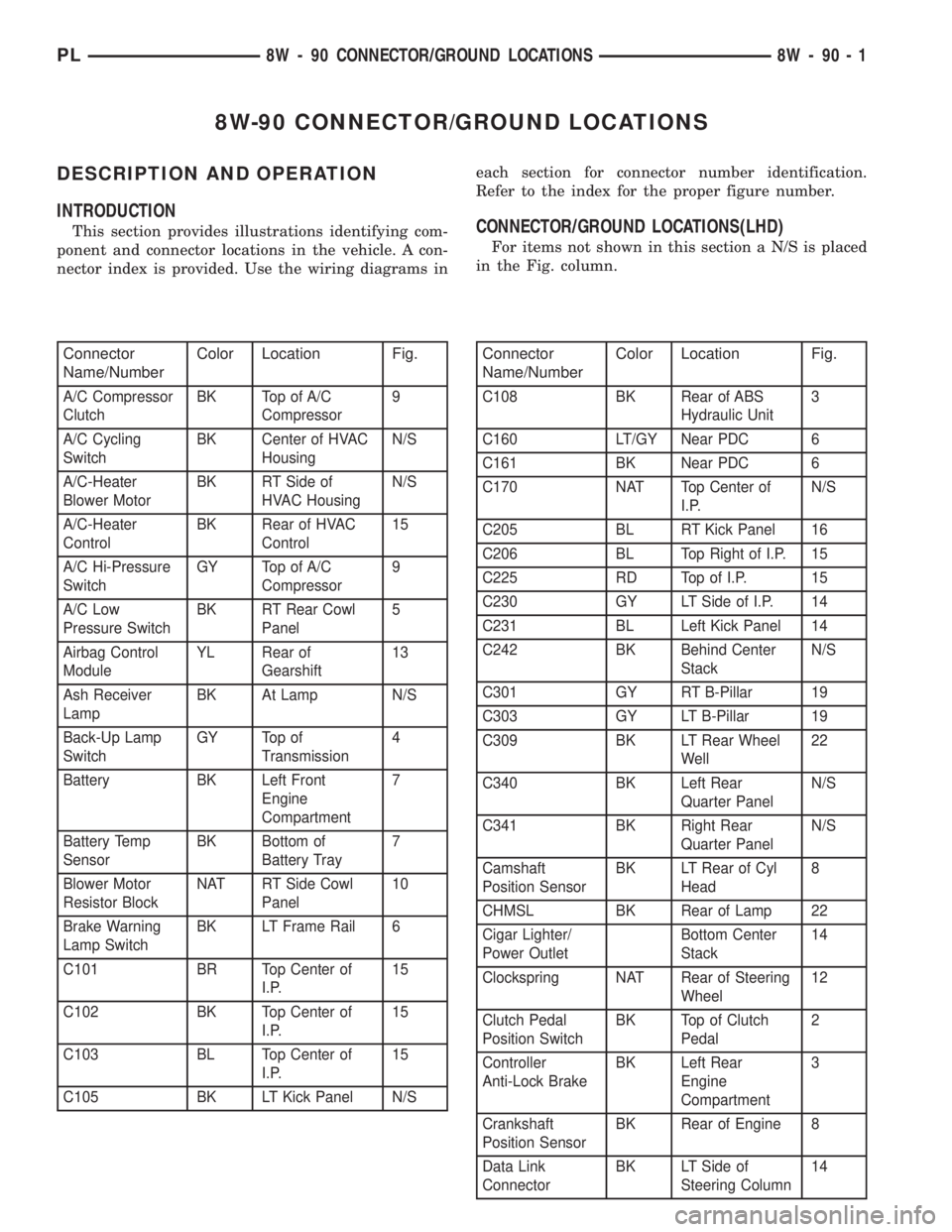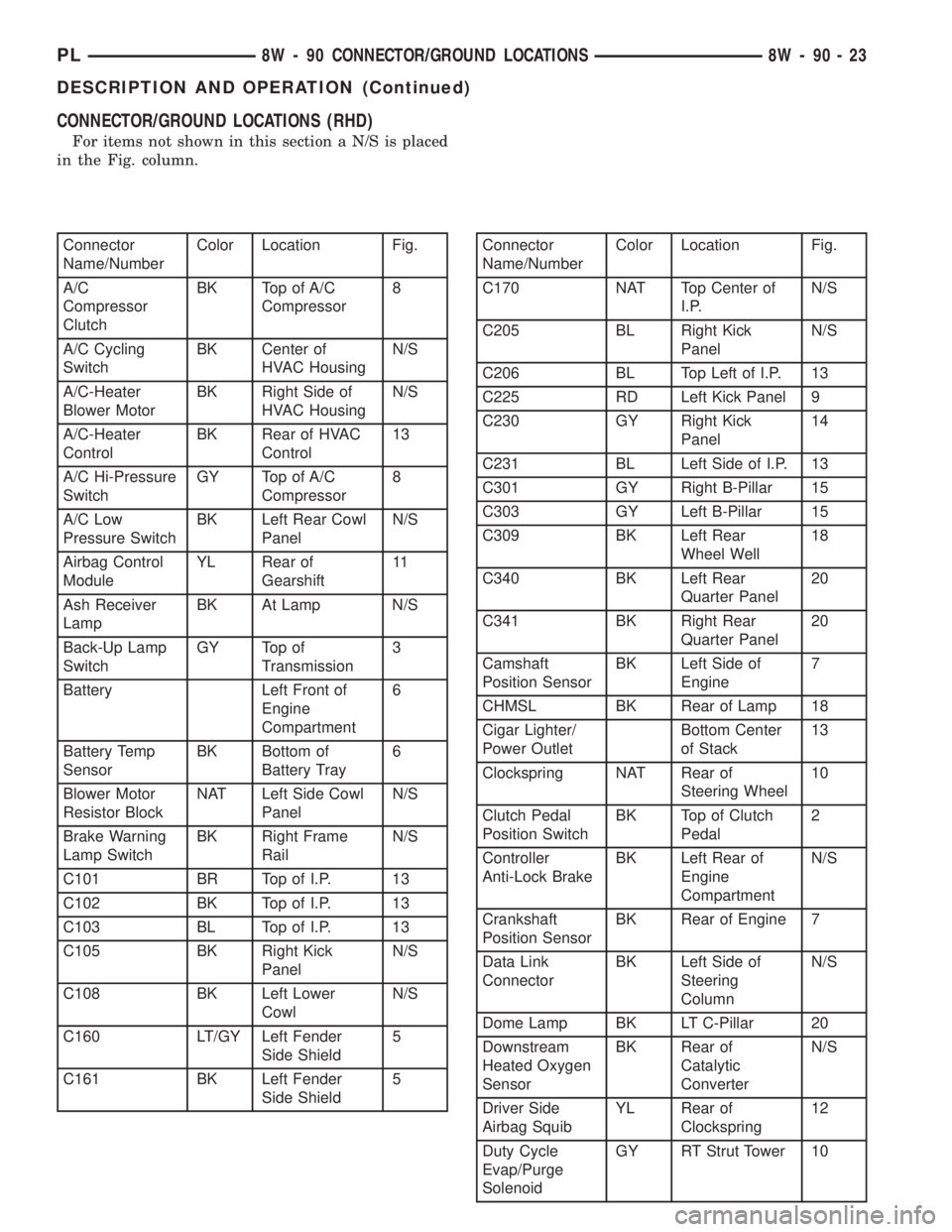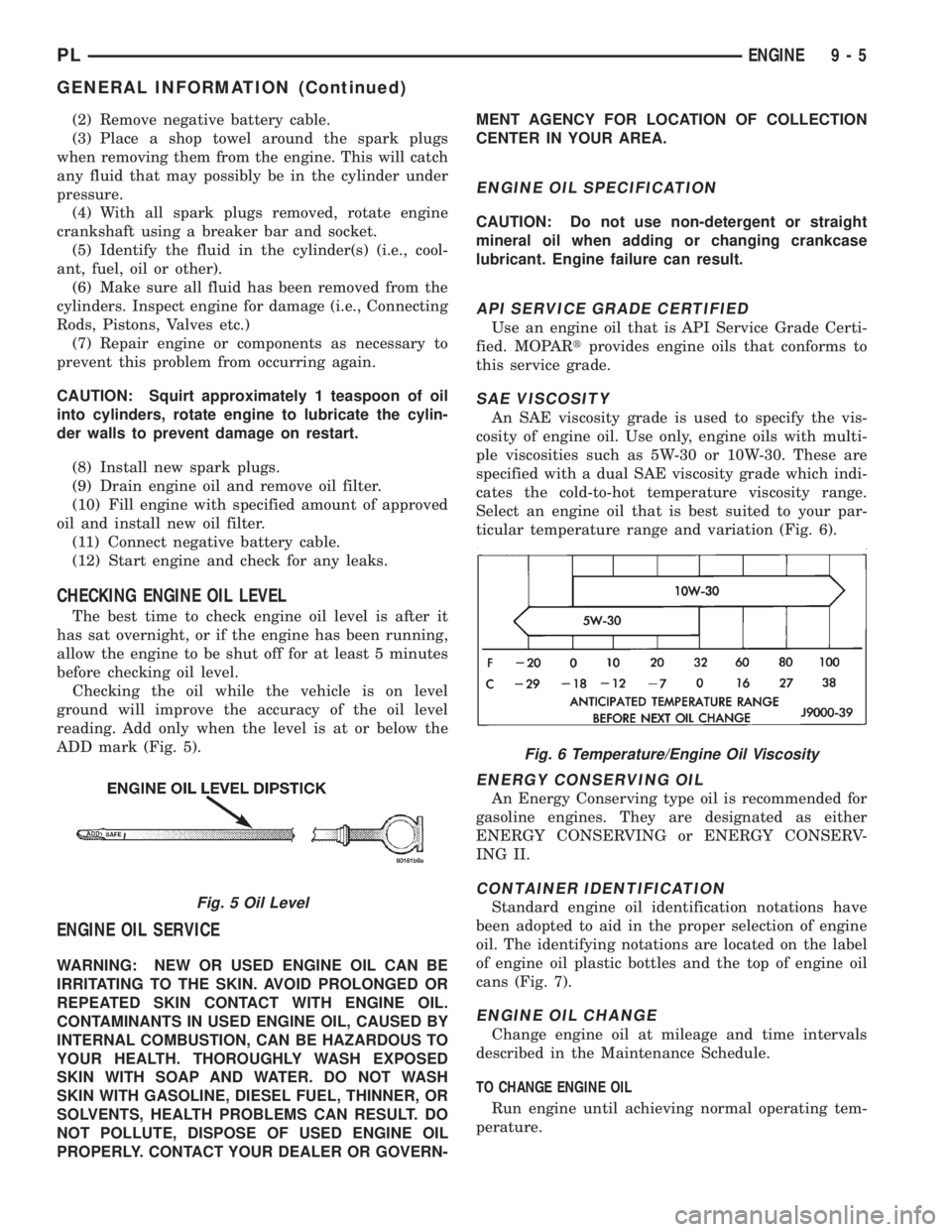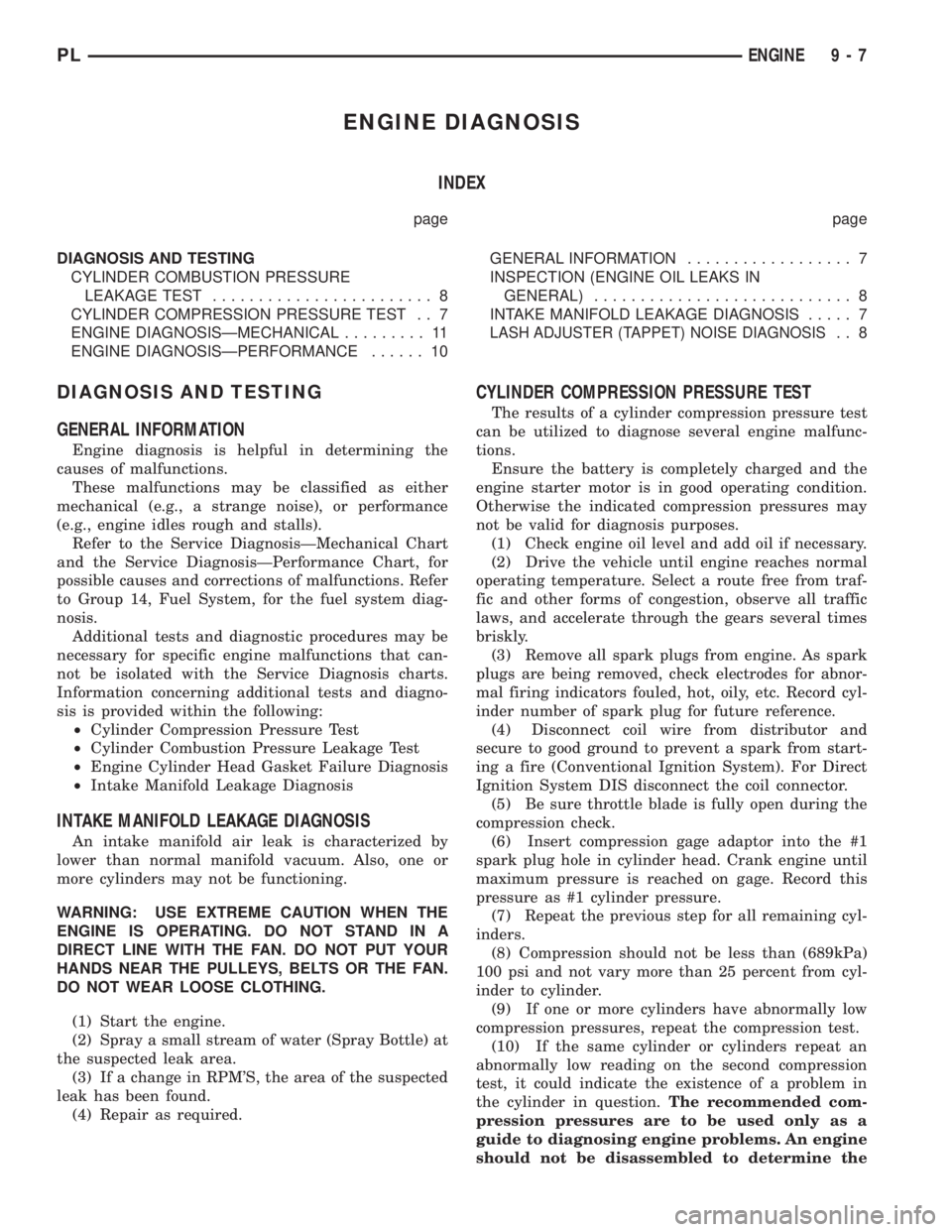1999 DODGE NEON warning
[x] Cancel search: warningPage 625 of 1200

CAV CIRCUIT FUNCTION
1 K7 20OR 8 VOLT SUPPLY
2 K4 20BK/LB SENSOR GROUND
3 K24 20GY/BK CRANKSHAFT POSITION SENSOR SIGNAL
CAV CIRCUIT FUNCTION
1- -
2- -
3 D1 20VT/BR CCD BUS (+)
4 Z12 22BK/TN GROUND
5 Z12 22BK/TN GROUND
6 D20 20LG SCI RECEIVE
7 D21 20PK SCI TRANSMIT
8- -
9- -
10 - -
11 D2 20WT/BK CCD BUS (-)
12 - -
13 - -
14 - -
15 - -
16 A14 16RD/WT FUSED B(+)
BLACK
18
916
CAV CIRCUIT FUNCTION
1 L3 16RD/OR DIMMER SWITCH HIGH BEAM OUTPUT
2- -
3 G9 22GY/BK RED BRAKE WARNING LAMP DRIVER
4 G34 16RD/GY HIGH BEAM INDICATOR DRIVER
5 G5 20DB/WT FUSED IGNITION SWITCH OUTPUT (RUN/START)
6 L20 14LG/WT FUSED B(+)
7- -
8 Z2 22BK/LG GROUND
9- -
10 L4 16VT/WT DIMMER SWITCH LOW BEAM OUTPUT
BLACK
51
10 6
31
BLACK
CRANKSHAFT
POSITION
SENSOR
DATA LINK
CONNECTOR
DAYTIME
RUNNING LAMP
MODULE
(CANADA)
8W - 80 - 16 8W-80 CONNECTOR PIN-OUTSPL
J988W-1PL008016
Page 631 of 1200

CAV CIRCUIT FUNCTION
1
X2 18DG/RD HORN RELAY OUTPUT 2Z1 20BK GROUND
CAV CIRCUIT FUNCTION
1 K59 18VT IDLE AIR CONTROL MOTOR NO. 4
2 K40 18BR/WT IDLE AIR CONTROL MOTOR NO. 1
3 K60 18YL/BK IDLE AIR CONTROL MOTOR NO. 2
4 K39 18GY/RD IDLE AIR CONTROL MOTOR NO. 3
CAV CIRCUIT FUNCTION
1 K17 18DB/TN IGNITION COIL NO. 2 DRIVER
2 A142 18DG/OR AUTOMATIC SHUT DOWN RELAY OUTPUT
3 K19 18BK/GY IGNITION COIL NO. 1 DRIVER
14
BLACK
31
BLACKBLACK
1
2
21BLACK
GROUND 20BK Z1
2
OUTPUT RELAY HORN 18DG/RD X2 1
FUNCTION CIRCUIT CAV
CAV CIRCUIT FUNCTION
1
X2 18DG/RD HORN RELAY OUTPUT 2Z1 20BK GROUND
BLACK
12
HORN
HORN NO. 1
HORN NO. 2
MOTOR CONTROL (IAC)IDLE AIR
IGNITION COIL
PACK (EXCEPT BUILT-UP-EXPORT)
(BUILT-UP-EXPORT)
(BUILT-UP-EXPORT)
FUSED IGNITION (RUN) F20 20WT D2
GROUND Z2 18BK/LG B2
FUSED B(+) M1 22PK B1
FUNCTION CIRCUIT CAV
HIGH SPEED
WARNING MODULE
(BUILT-UP-EXPORT)
BLACK
2 1ABCD
8W - 80 - 22 8W-80 CONNECTOR PIN-OUTSPL
J988W-1PL008022
Page 632 of 1200

GRAY
51
10 6
CAV CIRCUIT FUNCTION
1 Z1 22BK GROUND
2 G9 22GY/BK RED BRAKE WARNING LAMP DRIVER
3 A2 12PK/BK FUSED B(+)
4 A22 12BK/OR FUSED IGNITION (RUN)
5- -
6- -
7 A1 14RD FUSED B(+)
8 A31 14BK/WT FUSED IGNITION (RUN-ACC)
9 A21 14DB FUSED IGNITION (ST-RUN)
10
A41 14YL FUSED IGNITION (ST)
IMMOBILIZER SENSOR K240 20GY 2IMMOBILIZER SENSOR K24 20GY/BK 1
FUNCTION CIRCUIT CAV1 2
IGNITION
SWITCH
IMMOBILIZER
ENGINE SENSOR
GRAY
(BUILT-UP-EXPORT)
109
8
7
6
5
4
3
2
DOOR SWITCH GROUND M23 20YL/BK 1
FUNCTION CIRCUIT CAV
11
16 15
20
21
25
26 22
23
24 18 17
19 14 13
12
A41 16YL STARTER RELAY IN
K240 20GY K241 20GY/BK SIGNAL IN
SIGNAL OUT
K4 20BK/LB
K7 20OR
-SENSOR GROUND
8V SUPPLY
-
Z2 20BK/LG
P36 16PK/VTGROUND
DOOR UNLOCK OUT
P35 16OR/VT
A41 16YL
G5 20DB/WTDOOR LOCK IN
STARTER RELAY OUT
FUSED IGNITION (ST-RUN)
P35 16OR/VT P36 16PK/VT
F35 16RD/YL FUSED B(+)
DOOR UNLOCK IN
DOOR LOCK OUT --
--
--
--
--
--
--
--
--
--
--
26 14
13 1
(BUILT-UP-EXPORT)IMMOBILIZER
PL8W-80 CONNECTOR PIN-OUTS 8W - 80 - 23
PLI08023J988W-1
Page 633 of 1200

CAV CIRCUIT FUNCTION
1 M2 20YL* DOOR LIFT GROUND SWITCH
2 G34 16RD/GY HIGH BEAM INDICATOR DRIVER
2 L3 16RD/OR** DIMMER SWITCH HIGH BEAM OUTPUT
3 L60 22TN RIGHT TURN SIGNAL
4 G10 20LG/RD SEAT BELT SWITCH SENSE
5 G5 20DB/WT FUSED IGNITION SWITCH OUTPUT (ST-RUN)
6 M1 22PK FUSED B(+)
7 G21 22GY/LB TACHOMETER SIGNAL
8 Z3 16BK/OR GROUND
9 R41 18BK/TN AIRBAG WARNING LAMP DRIVER
10 G7 22WT/OR VEHICLE SPEED SENSOR SIGNAL
BLACK
51
10 6
** RKE
CAV CIRCUIT FUNCTION
1 G6 22GY OIL PRESSURE SWITCH SENSE
2 G19 22LG/OR ABS WARNING LAMP DRIVER
3 G3 22BK/PK CHECK ENGINE LAMP DRIVER
4 G20 22VT/YL ECT GAUGE SENSOR SIGNAL
5 G26 20LB KEY-IN IGNITION SWITCH SENSE
6 G9 22GY/BK RED BRAKE WARNING LAMP DRIVER
7 G12 22TN/BK GENERATOR LAMP DRIVER
8 L61 22LG LEFT TURN SIGNAL
9 E2 22OR PANEL LAMPS DRIVER
10 G4 20DB FUEL LEVEL SENSOR SIGNAL
BLACK
51
10 6
INSTRUMENT
CLUSTER - C1
CLUSTER - C2INSTRUMENT
* LHD
8W - 80 - 24 8W-80 CONNECTOR PIN-OUTSPL
J988W-1PL008024
Page 654 of 1200

8W-90 CONNECTOR/GROUND LOCATIONS
DESCRIPTION AND OPERATION
INTRODUCTION
This section provides illustrations identifying com-
ponent and connector locations in the vehicle. A con-
nector index is provided. Use the wiring diagrams ineach section for connector number identification.
Refer to the index for the proper figure number.CONNECTOR/GROUND LOCATIONS(LHD)
For items not shown in this section a N/S is placed
in the Fig. column.
Connector
Name/NumberColor Location Fig.
A/C Compressor
ClutchBK Top of A/C
Compressor9
A/C Cycling
SwitchBK Center of HVAC
HousingN/S
A/C-Heater
Blower MotorBK RT Side of
HVAC HousingN/S
A/C-Heater
ControlBK Rear of HVAC
Control15
A/C Hi-Pressure
SwitchGY Top of A/C
Compressor9
A/C Low
Pressure SwitchBK RT Rear Cowl
Panel5
Airbag Control
ModuleYL Rear of
Gearshift13
Ash Receiver
LampBK At Lamp N/S
Back-Up Lamp
SwitchGY Top of
Transmission4
Battery BK Left Front
Engine
Compartment7
Battery Temp
SensorBK Bottom of
Battery Tray7
Blower Motor
Resistor BlockNAT RT Side Cowl
Panel10
Brake Warning
Lamp SwitchBK LT Frame Rail 6
C101 BR Top Center of
I.P.15
C102 BK Top Center of
I.P.15
C103 BL Top Center of
I.P.15
C105 BK LT Kick Panel N/S
Connector
Name/NumberColor Location Fig.
C108 BK Rear of ABS
Hydraulic Unit3
C160 LT/GY Near PDC 6
C161 BK Near PDC 6
C170 NAT Top Center of
I.P.N/S
C205 BL RT Kick Panel 16
C206 BL Top Right of I.P. 15
C225 RD Top of I.P. 15
C230 GY LT Side of I.P. 14
C231 BL Left Kick Panel 14
C242 BK Behind Center
StackN/S
C301 GY RT B-Pillar 19
C303 GY LT B-Pillar 19
C309 BK LT Rear Wheel
Well22
C340 BK Left Rear
Quarter PanelN/S
C341 BK Right Rear
Quarter PanelN/S
Camshaft
Position SensorBK LT Rear of Cyl
Head8
CHMSL BK Rear of Lamp 22
Cigar Lighter/
Power OutletBottom Center
Stack14
Clockspring NAT Rear of Steering
Wheel12
Clutch Pedal
Position SwitchBK Top of Clutch
Pedal2
Controller
Anti-Lock BrakeBK Left Rear
Engine
Compartment3
Crankshaft
Position SensorBK Rear of Engine 8
Data Link
ConnectorBK LT Side of
Steering Column14
PL8W - 90 CONNECTOR/GROUND LOCATIONS 8W - 90 - 1
Page 676 of 1200

CONNECTOR/GROUND LOCATIONS (RHD)
For items not shown in this section a N/S is placed
in the Fig. column.
Connector
Name/NumberColor Location Fig.
A/C
Compressor
ClutchBK Top of A/C
Compressor8
A/C Cycling
SwitchBK Center of
HVAC HousingN/S
A/C-Heater
Blower MotorBK Right Side of
HVAC HousingN/S
A/C-Heater
ControlBK Rear of HVAC
Control13
A/C Hi-Pressure
SwitchGY Top of A/C
Compressor8
A/C Low
Pressure SwitchBK Left Rear Cowl
PanelN/S
Airbag Control
ModuleYL Rear of
Gearshift11
Ash Receiver
LampBK At Lamp N/S
Back-Up Lamp
SwitchGY Top of
Transmission3
Battery Left Front of
Engine
Compartment6
Battery Temp
SensorBK Bottom of
Battery Tray6
Blower Motor
Resistor BlockNAT Left Side Cowl
PanelN/S
Brake Warning
Lamp SwitchBK Right Frame
RailN/S
C101 BR Top of I.P. 13
C102 BK Top of I.P. 13
C103 BL Top of I.P. 13
C105 BK Right Kick
PanelN/S
C108 BK Left Lower
CowlN/S
C160 LT/GY Left Fender
Side Shield5
C161 BK Left Fender
Side Shield5Connector
Name/NumberColor Location Fig.
C170 NAT Top Center of
I.P.N/S
C205 BL Right Kick
PanelN/S
C206 BL Top Left of I.P. 13
C225 RD Left Kick Panel 9
C230 GY Right Kick
Panel14
C231 BL Left Side of I.P. 13
C301 GY Right B-Pillar 15
C303 GY Left B-Pillar 15
C309 BK Left Rear
Wheel Well18
C340 BK Left Rear
Quarter Panel20
C341 BK Right Rear
Quarter Panel20
Camshaft
Position SensorBK Left Side of
Engine7
CHMSL BK Rear of Lamp 18
Cigar Lighter/
Power OutletBottom Center
of Stack13
Clockspring NAT Rear of
Steering Wheel10
Clutch Pedal
Position SwitchBK Top of Clutch
Pedal2
Controller
Anti-Lock BrakeBK Left Rear of
Engine
CompartmentN/S
Crankshaft
Position SensorBK Rear of Engine 7
Data Link
ConnectorBK Left Side of
Steering
ColumnN/S
Dome Lamp BK LT C-Pillar 20
Downstream
Heated Oxygen
SensorBK Rear of
Catalytic
ConverterN/S
Driver Side
Airbag SquibYL Rear of
Clockspring12
Duty Cycle
Evap/Purge
SolenoidGY RT Strut Tower 10
PL8W - 90 CONNECTOR/GROUND LOCATIONS 8W - 90 - 23
DESCRIPTION AND OPERATION (Continued)
Page 718 of 1200

(2) Remove negative battery cable.
(3) Place a shop towel around the spark plugs
when removing them from the engine. This will catch
any fluid that may possibly be in the cylinder under
pressure.
(4) With all spark plugs removed, rotate engine
crankshaft using a breaker bar and socket.
(5) Identify the fluid in the cylinder(s) (i.e., cool-
ant, fuel, oil or other).
(6) Make sure all fluid has been removed from the
cylinders. Inspect engine for damage (i.e., Connecting
Rods, Pistons, Valves etc.)
(7) Repair engine or components as necessary to
prevent this problem from occurring again.
CAUTION: Squirt approximately 1 teaspoon of oil
into cylinders, rotate engine to lubricate the cylin-
der walls to prevent damage on restart.
(8) Install new spark plugs.
(9) Drain engine oil and remove oil filter.
(10) Fill engine with specified amount of approved
oil and install new oil filter.
(11) Connect negative battery cable.
(12) Start engine and check for any leaks.
CHECKING ENGINE OIL LEVEL
The best time to check engine oil level is after it
has sat overnight, or if the engine has been running,
allow the engine to be shut off for at least 5 minutes
before checking oil level.
Checking the oil while the vehicle is on level
ground will improve the accuracy of the oil level
reading. Add only when the level is at or below the
ADD mark (Fig. 5).
ENGINE OIL SERVICE
WARNING: NEW OR USED ENGINE OIL CAN BE
IRRITATING TO THE SKIN. AVOID PROLONGED OR
REPEATED SKIN CONTACT WITH ENGINE OIL.
CONTAMINANTS IN USED ENGINE OIL, CAUSED BY
INTERNAL COMBUSTION, CAN BE HAZARDOUS TO
YOUR HEALTH. THOROUGHLY WASH EXPOSED
SKIN WITH SOAP AND WATER. DO NOT WASH
SKIN WITH GASOLINE, DIESEL FUEL, THINNER, OR
SOLVENTS, HEALTH PROBLEMS CAN RESULT. DO
NOT POLLUTE, DISPOSE OF USED ENGINE OIL
PROPERLY. CONTACT YOUR DEALER OR GOVERN-MENT AGENCY FOR LOCATION OF COLLECTION
CENTER IN YOUR AREA.
ENGINE OIL SPECIFICATION
CAUTION: Do not use non-detergent or straight
mineral oil when adding or changing crankcase
lubricant. Engine failure can result.
API SERVICE GRADE CERTIFIED
Use an engine oil that is API Service Grade Certi-
fied. MOPARtprovides engine oils that conforms to
this service grade.
SAE VISCOSITY
An SAE viscosity grade is used to specify the vis-
cosity of engine oil. Use only, engine oils with multi-
ple viscosities such as 5W-30 or 10W-30. These are
specified with a dual SAE viscosity grade which indi-
cates the cold-to-hot temperature viscosity range.
Select an engine oil that is best suited to your par-
ticular temperature range and variation (Fig. 6).
ENERGY CONSERVING OIL
An Energy Conserving type oil is recommended for
gasoline engines. They are designated as either
ENERGY CONSERVING or ENERGY CONSERV-
ING II.
CONTAINER IDENTIFICATION
Standard engine oil identification notations have
been adopted to aid in the proper selection of engine
oil. The identifying notations are located on the label
of engine oil plastic bottles and the top of engine oil
cans (Fig. 7).
ENGINE OIL CHANGE
Change engine oil at mileage and time intervals
described in the Maintenance Schedule.
TO CHANGE ENGINE OIL
Run engine until achieving normal operating tem-
perature.
Fig. 5 Oil Level
Fig. 6 Temperature/Engine Oil Viscosity
PLENGINE 9 - 5
GENERAL INFORMATION (Continued)
Page 720 of 1200

ENGINE DIAGNOSIS
INDEX
page page
DIAGNOSIS AND TESTING
CYLINDER COMBUSTION PRESSURE
LEAKAGE TEST........................ 8
CYLINDER COMPRESSION PRESSURE TEST . . 7
ENGINE DIAGNOSISÐMECHANICAL......... 11
ENGINE DIAGNOSISÐPERFORMANCE...... 10GENERAL INFORMATION.................. 7
INSPECTION (ENGINE OIL LEAKS IN
GENERAL)............................ 8
INTAKE MANIFOLD LEAKAGE DIAGNOSIS..... 7
LASH ADJUSTER (TAPPET) NOISE DIAGNOSIS.. 8
DIAGNOSIS AND TESTING
GENERAL INFORMATION
Engine diagnosis is helpful in determining the
causes of malfunctions.
These malfunctions may be classified as either
mechanical (e.g., a strange noise), or performance
(e.g., engine idles rough and stalls).
Refer to the Service DiagnosisÐMechanical Chart
and the Service DiagnosisÐPerformance Chart, for
possible causes and corrections of malfunctions. Refer
to Group 14, Fuel System, for the fuel system diag-
nosis.
Additional tests and diagnostic procedures may be
necessary for specific engine malfunctions that can-
not be isolated with the Service Diagnosis charts.
Information concerning additional tests and diagno-
sis is provided within the following:
²Cylinder Compression Pressure Test
²Cylinder Combustion Pressure Leakage Test
²Engine Cylinder Head Gasket Failure Diagnosis
²Intake Manifold Leakage Diagnosis
INTAKE MANIFOLD LEAKAGE DIAGNOSIS
An intake manifold air leak is characterized by
lower than normal manifold vacuum. Also, one or
more cylinders may not be functioning.
WARNING: USE EXTREME CAUTION WHEN THE
ENGINE IS OPERATING. DO NOT STAND IN A
DIRECT LINE WITH THE FAN. DO NOT PUT YOUR
HANDS NEAR THE PULLEYS, BELTS OR THE FAN.
DO NOT WEAR LOOSE CLOTHING.
(1) Start the engine.
(2) Spray a small stream of water (Spray Bottle) at
the suspected leak area.
(3) If a change in RPM'S, the area of the suspected
leak has been found.
(4) Repair as required.
CYLINDER COMPRESSION PRESSURE TEST
The results of a cylinder compression pressure test
can be utilized to diagnose several engine malfunc-
tions.
Ensure the battery is completely charged and the
engine starter motor is in good operating condition.
Otherwise the indicated compression pressures may
not be valid for diagnosis purposes.
(1) Check engine oil level and add oil if necessary.
(2) Drive the vehicle until engine reaches normal
operating temperature. Select a route free from traf-
fic and other forms of congestion, observe all traffic
laws, and accelerate through the gears several times
briskly.
(3) Remove all spark plugs from engine. As spark
plugs are being removed, check electrodes for abnor-
mal firing indicators fouled, hot, oily, etc. Record cyl-
inder number of spark plug for future reference.
(4) Disconnect coil wire from distributor and
secure to good ground to prevent a spark from start-
ing a fire (Conventional Ignition System). For Direct
Ignition System DIS disconnect the coil connector.
(5) Be sure throttle blade is fully open during the
compression check.
(6) Insert compression gage adaptor into the #1
spark plug hole in cylinder head. Crank engine until
maximum pressure is reached on gage. Record this
pressure as #1 cylinder pressure.
(7) Repeat the previous step for all remaining cyl-
inders.
(8) Compression should not be less than (689kPa)
100 psi and not vary more than 25 percent from cyl-
inder to cylinder.
(9) If one or more cylinders have abnormally low
compression pressures, repeat the compression test.
(10) If the same cylinder or cylinders repeat an
abnormally low reading on the second compression
test, it could indicate the existence of a problem in
the cylinder in question.The recommended com-
pression pressures are to be used only as a
guide to diagnosing engine problems. An engine
should not be disassembled to determine the
PLENGINE 9 - 7